Civil War and Reconstruction
Knoxville/East TN
The Battle of Knoxville was part of a bloody contest between the Union and Confederate armies for control of East Tennessee during 1863.
Union troops invaded East Tennessee. In early September, Union soldiers commanded by Major General Ambrose Burnside seized Knoxville. Then, on September 19 and 20, the Battle of Chickamauga was fought near the town of Chattanooga. The Union army lost this battle and retreated into Chattanooga. General Braxton Bragg and his Confederates surrounded them.
After winning the Battle of Chickamauga, Bragg sent General James Longstreet and his men to attack Knoxville early in November. When Burnside realized the Confederates were about to strike, he pulled the Union troops into the city which was protected by fortifications. Some of the Union soldiers were stationed at Fort Sanders, which formed part of Knoxville’s defenses.
At first, the Confederates tried surrounding Knoxville. They hoped that by preventing food and other supplies from entering the city, they would force the Union soldiers to surrender. Then, Longstreet decided to attack Fort Sanders on November 29.
Before dawn, the Confederates started moving towards Fort Sanders’s walls. In the dark, many soldiers ran into a telegraph line, causing considerable confusion. When they reached the fort, Union soldiers poured water on the walls. This froze and formed ice making the walls very slippery and difficult to climb. Also, the Confederates dis-cover-ed they had lost their ladders they planned to use to climb over the fort’s walls. Meanwhile, the Union soldiers fired their guns and cannons at the Confederates.
The Union soldiers at Fort Sanders won the fight. The Confederates lost about 800 men as casualties (killed, wounded, captured, or missing) while five Union soldiers were killed and eight were injured in the battle.
After Longstreet learned of the defeat at Fort Sanders and heard about the Union army’s victory in the Battle of Chattanooga, he decided it was time to retreat. His men marched out of Knoxville towards upper East Tennessee where they camped for the winter.
Picture Credits:
- "Longstreet's assault upon Fort Sanders"
- Photograph of military bridge at Strawberry Plains with fort in background and sentry at the right. The fort on the hill in the background is tentatively identified as Fort Stanley. Photograph taken in 1863 after Conf. Gen. Longstreet withdrew from Fort Sanders. Photographer: George Barnard. Library of Congress
- Photograph of a blockhouse on the Tennessee River at Knoxville. A blockhouse is a small military building with openings to fire through. It is used as part of a defensive system or as an observation point. Library of Congress
- Detail from drawing showing fighting at the Battle of Knoxville. Published in Harper's Weekly. Library of Congress
- Photograph of Knoxville with Union tents in foreground and the city in the background next to the Tennessee River. This photograph was taken in December 1863 after Confederate General James Longstreet withdrew his troops from the seige of Union troops in Knoxville. Photographer: George Barnard. Library of Congress
- Print of the painting "Attack on Knoxville," by Thomas Nast. Attributed to Johnson, Fry & Co. of New York, New York Public Library Digital Gallery
- Newspaper drawing showing Union General Ambrose Burnside entering Knoxville to an enthusastic reception from "the Unionists of Knoxville." Tennessee State Museum (TSM) Collection, 83.57.1A
Civil War and Reconstruction >> Civil War >> Battles >> Knoxville/East TN
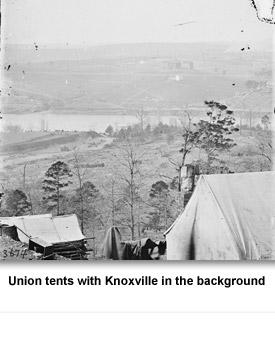
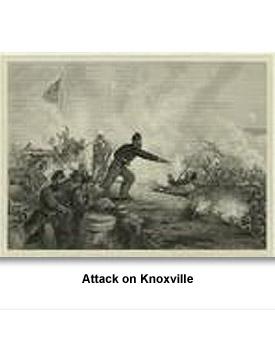
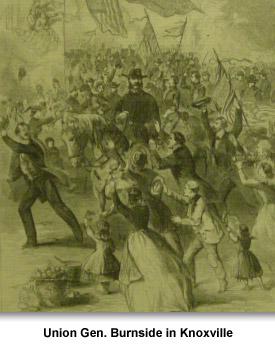
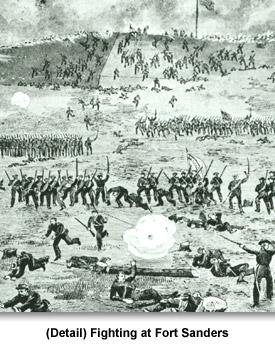
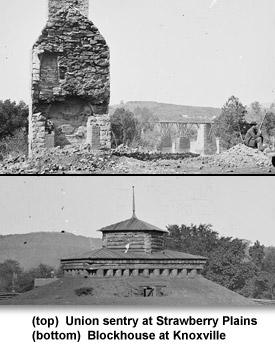
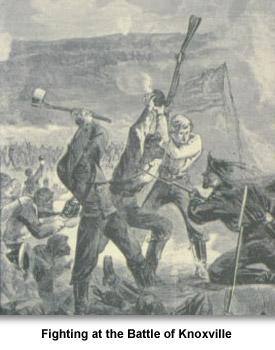
 Sponsored by: National Endowment for the Humanities
Sponsored by: National Endowment for the Humanities